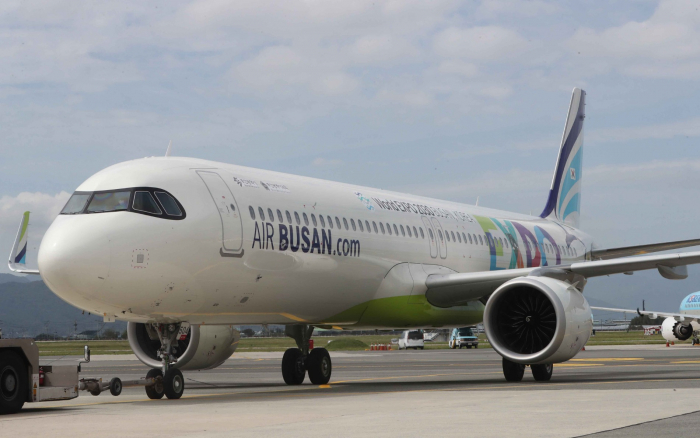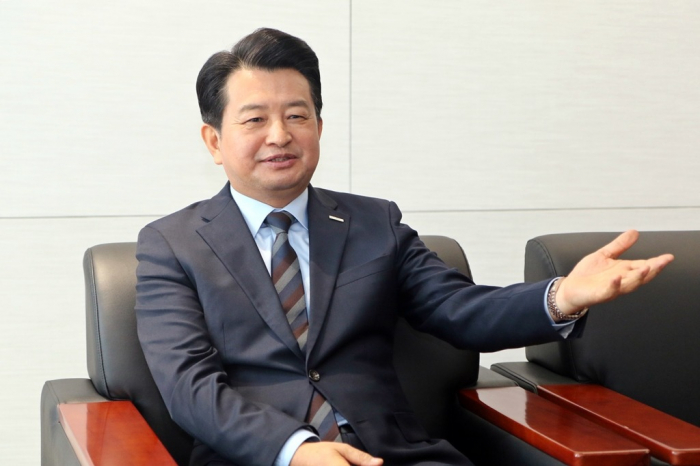Airlines
Air Busan targets record profit with more int’l flights
Japanese routes make up 60% of the South Korean LCC's international flights, the remaining go to Southeast Asia; eyes more in China
By May 30, 2023 (Gmt+09:00)
2
Min read
Most Read
LG Chem to sell water filter business to Glenwood PE for $692 million


Kyobo Life poised to buy Japan’s SBI Group-owned savings bank


KT&G eyes overseas M&A after rejecting activist fund's offer


StockX in merger talks with Naver’s online reseller Kream


Mirae Asset to be named Korea Post’s core real estate fund operator



Air Busan Co., a South Korean low-cost carrier, targets record earnings with more international flights, especially to neighboring China and Japan, by taking advantage of growing demand for those lucrative routes, its chief executive said on Tuesday.
The budget airline based in Busan, about 400 kilometers southeast of Seoul, aims to maximize profitability by cutting costs this year while emphasizing safety, its CEO Ahn Byeong-seok told The Korea Economic Daily in an interview.
“We will try to beat market forecasts by flexibly operating routes, maintaining the top position in Busan and increasing international flights from Incheon International Airport,” Ahn said, referring to the country’s main gateway.
Financial analysts predicted Air Busan, an LCC of the country’s second-largest carrier Asiana Airlines Inc., to report an operating profit of more than 96 billion won ($72.5 million) and sales of over 800 billion won, which both are all-time highs, according to Ahn. In 2022, it suffered an operating loss of 81.3 billion won and sales of 405 billion won.
Air Busan already reported an operating profit of 47.8 billion won in the first quarter of 2023, swinging from a loss of 36.3 billion won a year earlier, as sales more than quadrupled to 213.1 billion won, according to its earnings report.
FOCUSES ON JAPAN, BUT WILL EXPAND MORE
The LCC operates 21 aircraft, smaller than its larger rivals such as T'way Air Co. and Jin Air Co., which run 30 airplanes and 26 units, respectively. Air Busan, however, reported an operating profit margin of 22.5% in the January-March period, not far from the margins of Jin Air’s 24.1% and T’way’s 23%.
That came as Air Busan concentrated on flights to Japan, Ahn said.
“Air Busan relies on Japan more than other carriers with flights to the country accounting for about 60% of its total international services,” he said. “We plan to flexibly operate the remaining 40% focusing on Southeast Asia.”
“We will raise flights to Japan by adding new routes such as Chitose, although the 60% ratio may dip in the second half when we get more flights to China,” he said, referring to a city in Hokkaido, Japan.
The budget carrier aims to expand international flights further.
“We operated eight international flights from Incheon International Airport in the first quarter and we found that they were profitable,” said Ahn.
“We plan to increase international flights from the Seoul Metropolitan Area,” he said. The region, which includes the capital, Incheon and the surrounding Gyeonggi Province, has the other airfield – Gimpo International Airport – in Seoul.

The company is set to hire more personnel for the business expansions including more than 30 flight attendants, 20 mechanics and 20 general workers, Ahn said.
Write to Mi-Sun Kang at misunny@hankyung.com
Jongwoo Cheon edited this article.
More to Read
-
 AirlinesAir Busan to offer 4 daily flights on Busan-Osaka route
AirlinesAir Busan to offer 4 daily flights on Busan-Osaka routeJan 26, 2023 (Gmt+09:00)
1 Min read -
 AirlinesAir Busan offers 4 daily flights on Busan-Fukuoka route
AirlinesAir Busan offers 4 daily flights on Busan-Fukuoka routeDec 07, 2022 (Gmt+09:00)
1 Min read
Comment 0
LOG IN


